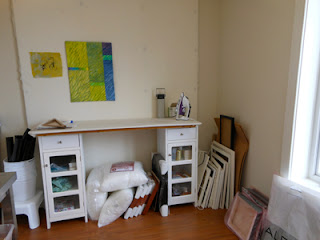
When I taught at Kingston three weeks ago, I was asked to describe my studio. "Perhaps this would make an interesting blog post", I thought to myself.
Two or three years ago. when my younger daughter moved out, I had the wall between the two girls' bedrooms knocked down to make myself a new studio. I had been working in a small downstairs bedroom, and this was a chance to double my space, increase the natural light, and add a wet work station. The total floor space measures 25' x 11".
I went to work with graph paper and an Ikea catalog, and carefully planned things out. Here you can see what is immediately to the right of the door when entering. The cutting table is made by Horn of America. My fabrics are all folded and sorted in rattan baskets from Ikea, protected from sunlight and dust. I used the measurements of the baskets when ordering the custom-built storage unit to hold them. The labels read, "Hand-dyes, Red and Purple", for example. Notice the cardboard window frame on the pegboard for my 12"x12" challenge pieces for 12bythedozen.
Moving around the room counter-clockwise, more furniture from Horn, and my trusty Bernina 150 sewing machine, now more than 10 years old. On the walls are bits of inspiration and personal momentos. The storage unit under the table is separate, and holds mostly thread. In the bottom drawer are all kinds of odds and ends, like metal washers, zippers and copper mesh.
Everything described to this point was in my old studio, fitted out maybe eight years ago.
Immediately to the left of the door is a storage unit from Ikea, filled with books and magazines. Inside the storage boxes are collage materials clipped from magazines and old books, or ordered from Etsy. Ribbons and fancy yarns are wrapped around cardboard tubes.
I love the vintage suitcases above, and I use them to transport papers to collage workshops. I intend to collage the suitcases themselves one day to make them really special.
What I never figured on when I made the floor plan was how useful the little nooks and corners would be for storage. To the left of the unit are bolts of pfd cotton, and on the right is a massive roll of batting. Aprons hang on the back of the door.
This wall juts out a bit to accommodate the bathroom sinks on the other side. I took the practical route and located the sink back-to-back with the bathroom plumbing. The sink counter and the metal storage shelves beside it were found at Ikea. My portfolio of drawings slides underneath the shelving, and in the cupboards under the sink are two big bins filled with dye equipment.
The poster on the wall is from the recent Women's Art Society of Montreal show. An image of my work was used by Ogilvy's to promote the show.
The laminate flooring was found at a bargain price, and suits the purpose nicely.
I have a wide board for ironing that doubles as a work table. It's supported by storage units from Reno Depot that hold specialty items like foil and heat guns. I wanted to maximize the usefulness of the ironing space to include storage. Under the ironing board are pillow forms and frames.
A few years ago I scavenged some old picture frames and painted them white. I'm not quite ready to let them go.

The design wall is made of foam insulation boards mounted to the wall and covered with batting. I can pin heavier items up there, but most often bits of fabric adhere without pinning.
In between two windows overlooking the lake is another table from Ikea, with a rolling storage unit underneath. On top of the table are a radio / CD player, a printer, a phone and my laptop. CD's are stored in the wall unit. Jars hold bits of lace and angelina fibre, and large flat storage boxes are filled with tissue paper. A calendar is positioned on the cork board, as well as multiple "to do" lists, a dye colour chart, and my quilted Curlylocks avatar.
Would I do anything differently if I were to design the studio again? I definitely went overboard on the task lighting. Mostly I just use the full-spectrum fluorescent fixtures overhead.
Much of the material in my studio is stuff I am not currently using in my work, but I don't see the need to toss it because I just might need it some day :-) I am so grateful to have this bright and functional work area!

































